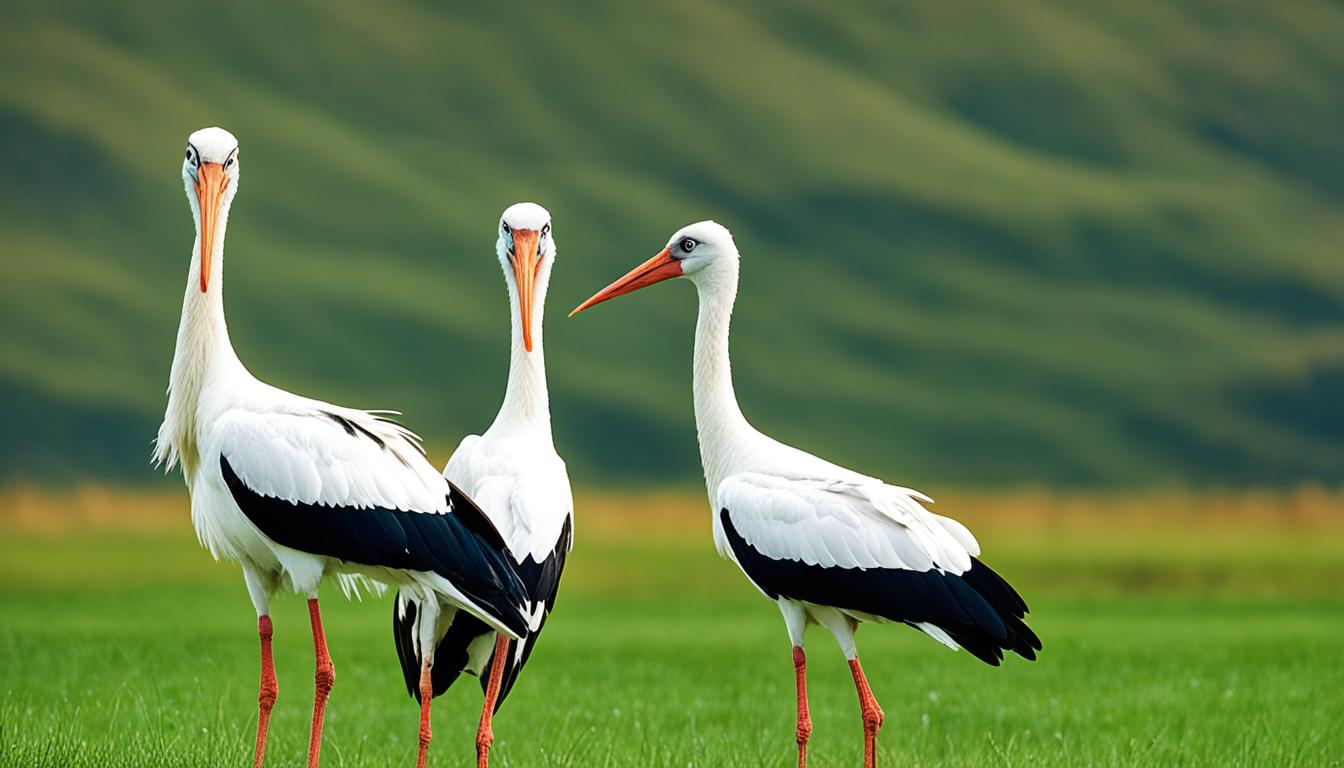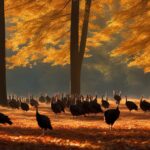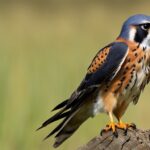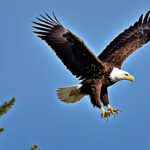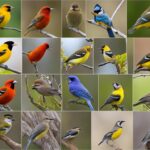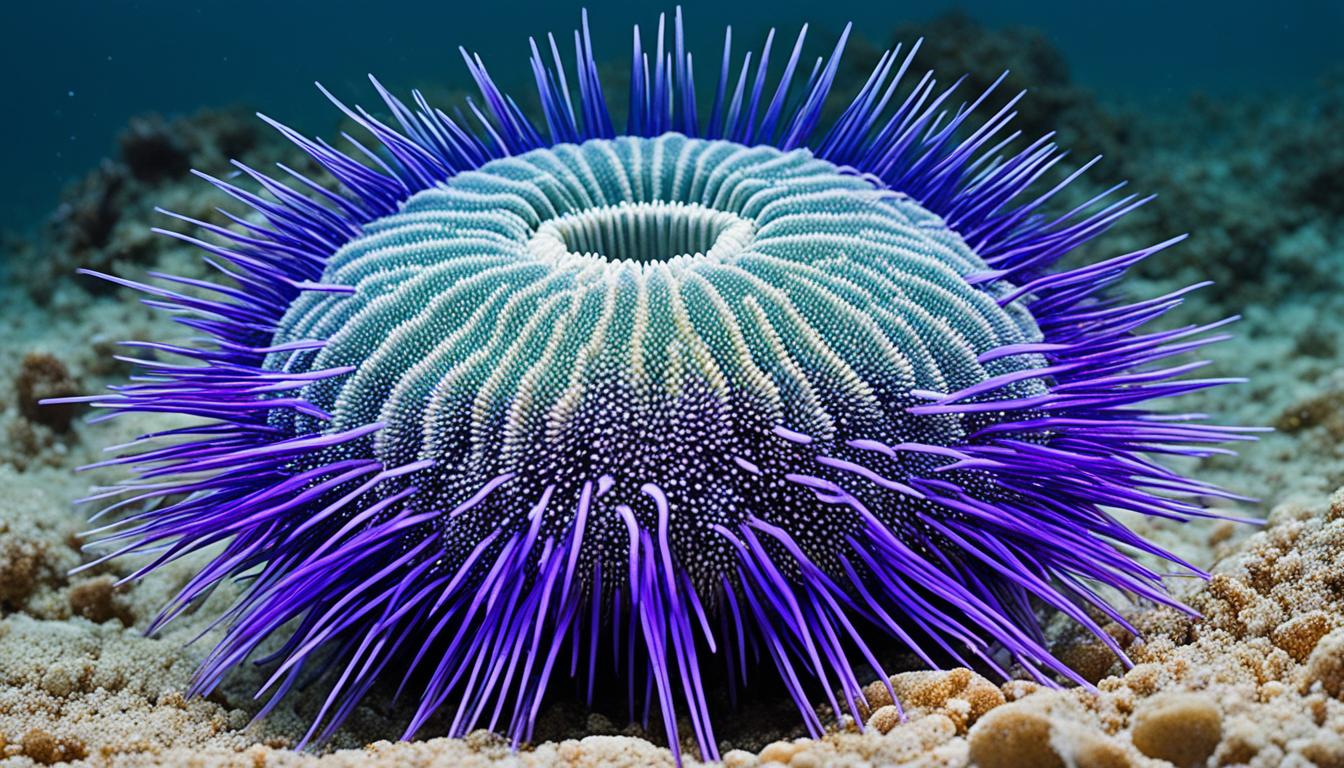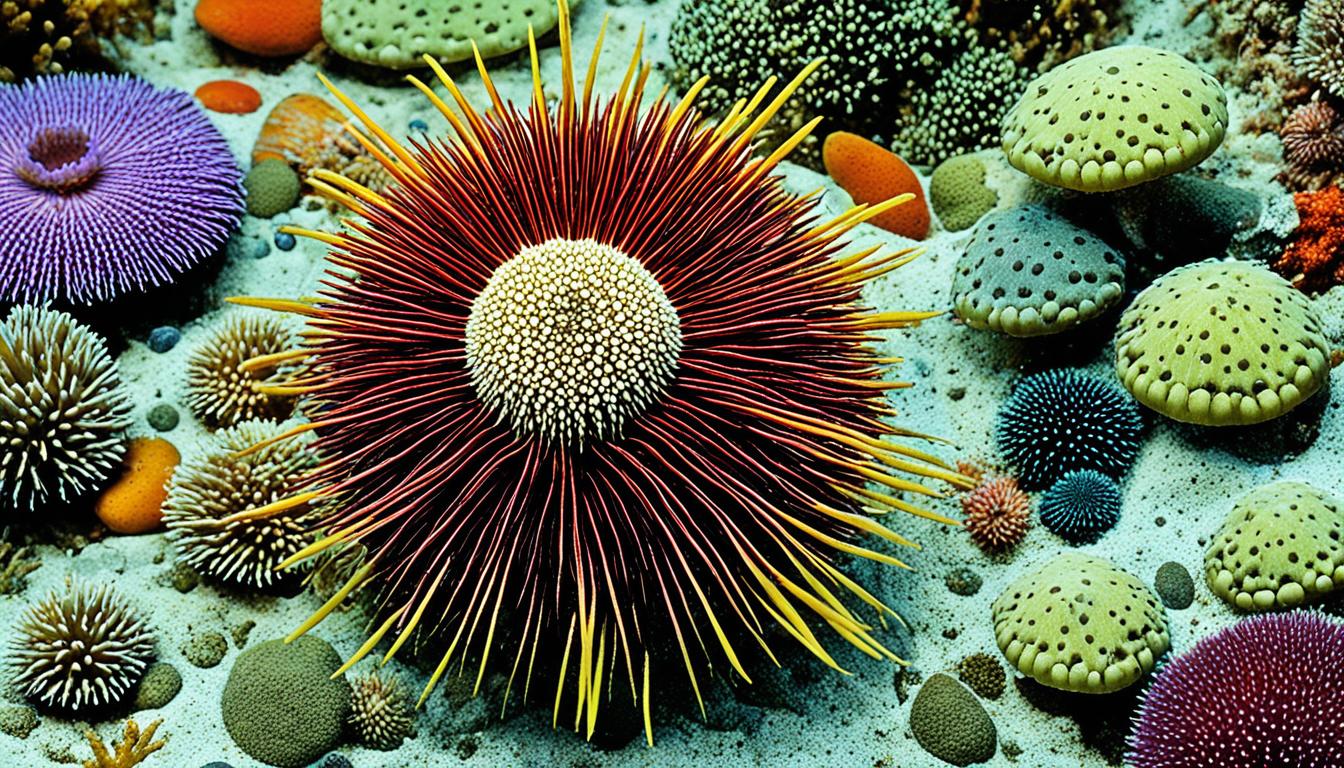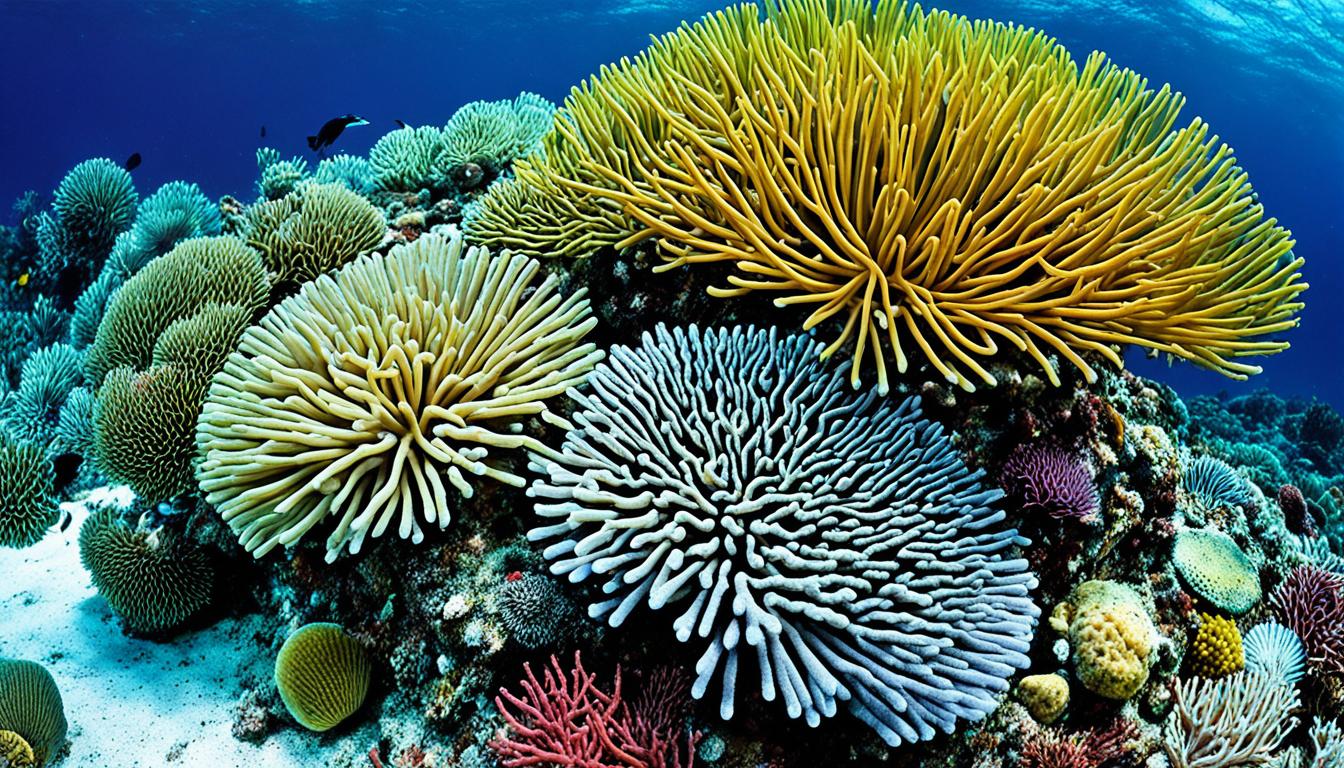Ever thought about seeing wild storks in the USA? There’s a unique one here. It’s called the Wood Stork. It’s the only kind that breeds in North America.
These storks have black and white bodies. Their heads are gray and scaly, without many feathers. They are a striking part of the stork group in the USA.
The government says they are ‘Threatened.’ Yet, the world wildlife group considers them ‘Least Concern.’ They are really beautiful to see. In the USA, you’ll find them breeding from Florida to South Carolina. When it’s not breeding time, they might fly all the way to South America.
Overview of Wild Storks in the United States
In the United States, the Wood Stork is key among wild stork species. It’s important for the environment. Being the only stork that breeds in North America, their presence signifies the health of wetlands. This is why protecting their habitats matters a lot.
Wood Storks are specially looked after because they’re in danger, marked as “Threatened” under federal laws. This calls for intense efforts to save their homes and keep an eye on them. Helping these storks shows how we are fighting for all nature and its balance.
Watching and studying these storks gives a lot of information to bird scientists and fans. We learn a ton about these birds by looking at how they live, breed, and travel. This helps us figure out how to keep them safe from dangers.
Wood Stork: The Only Breeding Stork in North America
The Wood Stork stands out among North American storks. It’s easy to spot because of its unique looks and how it behaves. This dives into what makes the Wood Stork special. We’ll look at its features, how it acts, and its place in bird society.
Identification and Physical Characteristics
The Wood Stork is known for being tall with wide wings. It’s one of the tallest in North America. Adults have a head without feathers that’s gray, a black bill, and legs. Their bodies are mostly white with bold black feathers on their wings. They make hissing sounds since they don’t have vocal cords.
Behavior and Social Structure
Stork behavior is quite interesting because of how social they are. They like to live and nest with a lot of other storks. These North American storks often work together for things like finding food. Wood Storks have a special way of hunting. They put their open bills in the water to feel for fish. This unique method helps them find food and survive.
Learning about their physical characteristics and actions adds to our appreciation for them. It’s clear they play a big role in their environment.
Habitat and Distribution of Wood Storks in the USA
Wood Storks live across the southeastern U.S. in various wetland areas. The type of place they live in depends on where they can find food and breed.
Preferred Environments
Wood Storks like places with mixed hardwood forests, sloughs, and mangroves. They also need cypress domes or strands to find food and build nests. These birds look for wetlands that are just the right depth for them to hunt in easily. They need a mix of freshwater and estuarine (where rivers meet the sea) marshes because of what they eat.
Geographical Range
Florida is where Wood Storks are most common in the U.S. They are also found in Georgia, South Carolina, and North Carolina during breeding. But, they fly to northern Argentina in the non-breeding season. This shows their wide reach across different ecosystems.
| Region | Habitat Type | Breeding Presence |
|---|---|---|
| Florida | Mixed hardwood swamps, sloughs, mangroves, cypress domes | High |
| Georgia | Freshwater marshes, estuarine marshes | Moderate |
| South Carolina | Freshwater wetlands | Low |
| North Carolina | Estuarine marshes | Low |
To help Wood Storks, we must know about their habitat and where they live. Protecting the places they need can keep these fantastic birds around for future generations.
Breeding and Nesting Habits of Wood Storks
Understanding how Wood Storks breed is key to saving them. They form big nesting groups, choosing sites based on water access. This shows their strong link to water for making nests and having babies.
Nesting Locations and Colony Formation
Wood Storks like trees in water for nests, keeping them safe from harm. They prepare nests with great detail, using twigs and more. Their colonies are huge, with up to hundreds of nests together, helping each other live better.
Egg Laying and Incubation
When it’s time to have babies, Wood Storks lay eggs over a period, mainly in Florida. They lay two to five eggs each year, ensuring the species goes on. Both parents help keep the eggs warm for about 30 days, which is amazing and aids in new life arriving.
Are there wild storks in the USA?
Yes, the USA does have wild storks, and they are known as Wood Storks. These storks are unique and play important ecological roles. They have faced many challenges over time, affecting their numbers and where they live.
But, the presence of these storks is still strong, adding to the variety of life in their areas. You can often see them in the wetlands of the southeastern United States. Their way of breeding and finding homes is very interesting for those who love birds and study them.
Learning about these storks helps us protect their homes and species. We can help keep them thriving with more care and by spreading the word. The Wood Stork shows us how well our wetlands are doing.
| Aspect | Details |
|---|---|
| Species | Wood Stork (Mycteria americana) |
| Range | Southeastern USA, primarily Florida, extending to South America |
| Habitat | Wetlands, including freshwater and estuarine marshes |
| Conservation Status | Federally-designated Threatened, IUCN Least Concern |
Diet and Foraging Techniques of Wood Storks
It’s key to know what the Wood Stork eats to understand its way of life. These birds eat small to medium-sized fish, frogs, and shellfish. They have a unique way of hunting that sets them apart.
They hunt by feeling in the water with their open bills. When they touch something, they quickly snap their bills to catch the prey.
How well this hunting method works depends a lot on the water levels where they live. If the water is low, the food is easier to find, making life better for the storks. So, having the right wetland conditions is vital for these birds to eat well and survive.
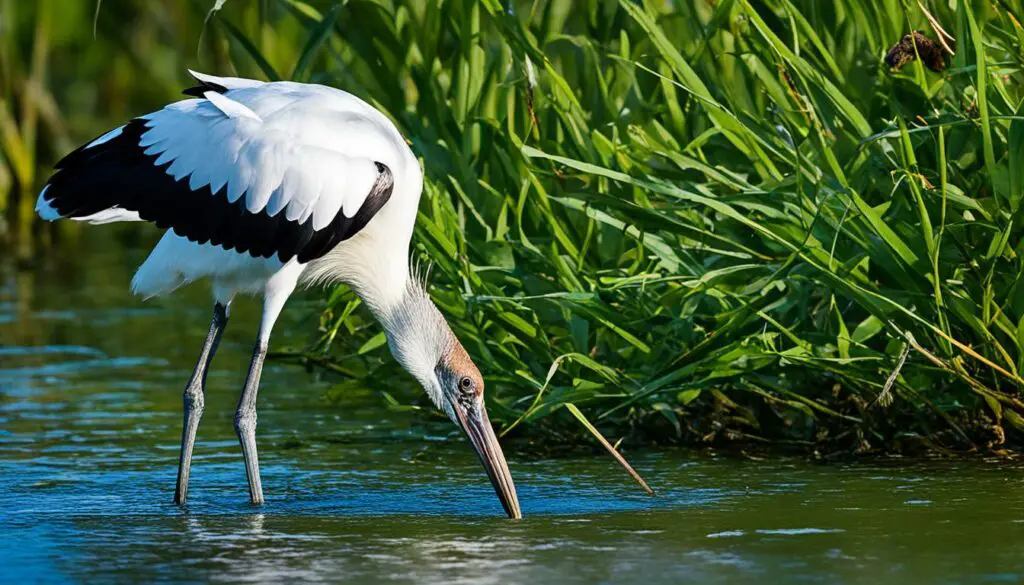
- Utilization of tactile hunting through water
- Primary diet includes fish, amphibians, and crustaceans
- Reliance on specific wetland water levels for efficient prey capture
Knowing about the stork’s foraging ways helps us protect them. By managing the wetlands, we can make sure these birds have what they need to eat. This is key to keeping Wood Storks around in the U.S.
Threats to the Wood Stork Population
Wood Storks face many dangers despite their strong nature. These threats have a big impact on their survival. They harm how Wood Storks live and act naturally.
Habitat Destruction
Expanding farms and cities are a big threat to Wood Storks. They lead to the destruction of important wetlands. These wetlands are needed for nesting and finding food. Losing these areas upsets the birds’ nature home, making life hard for them.
Climate Change and Water Management
Climate change is a huge challenge for storks. It changes the weather, leading to floods or droughts. This also upsets the water levels they rely on. With these changes, Wood Storks find it hard to feed and breed successfully.
Predation and Human Impact
Being preyed on, mainly by raccoons, is another big threat. Humans also hurt storks through building, disturbing them, and taking their eggs. This threat adds to their already tough life. This makes protecting them more urgent.
| Threat | Impact on Wood Storks |
|---|---|
| Habitat Destruction | Loss of nesting and foraging grounds |
| Climate Change | Unpredictable water levels affecting breeding and foraging |
| Predation | Egg and chick predation by raccoons |
| Human Impact | Disturbances and egg harvesting |
Conservation Efforts for Wood Storks
Helping Wood Storks stay in the United States needs a big team effort. Many groups work together, along with laws, to keep Wood Storks safe. Plans are in place to protect them using both state and national guidelines.
Federal Protections
The Wood Stork functions under a mix of federal laws. The U.S. Migratory Bird Treaty Act and the Endangered Species Act offer it special protections. These acts make fighting dangers like losing their homes and too much human presence easier.
Recovery and Management Plans
For the Wood Stork to bounce back, several recovery plans are in play. The focus is on making homes for them better and dealing with shrinking numbers. These plans work on saving wetlands, managing water, and making sure people know about the storks.
| Plan Type | Focus Area | Initiatives |
|---|---|---|
| Federal Protections | Legal and Legislative | Implementation of U.S. Migratory Bird Treaty Act and Endangered Species Act |
| Recovery Plans | Habitat Restoration | Wetland conservation, breeding site protection |
| Management Plans | Population Management | Water level regulation, community engagement |
Observing Wild Storks in the USA
Seeing wild storks in the USA is a special chance. It lets you see the majestic Wood Stork in its home. These birds are often in the southeast. There, they add to the joy of birdwatching and teaching us about stork life.
Best Locations for Birdwatching
Florida and South Carolina are prime spots for watching wild Wood Storks. Places like Everglades National Park, Corkscrew Swamp Sanctuary, and Savannah National Wildlife Refuge are great. You can enjoy seeing storks and many other types of animals there, making your visit even more special.
Tips for Enthusiasts
For a great time watching wild storks, remember these tips:
- Time Your Visit: Early mornings or late afternoons are best. Storks are most active then, giving you a better view.
- Equip Properly: Have binoculars and a good camera ready. This lets you see the storks up close and remember the moment forever.
- Respect Their Habitat: Keep your distance to not upset the storks as they go about their day. It’s important to protect where they live by following local rules.
- Learn About Their Behavior: Knowing how Wood Storks eat and live can make your birdwatching richer. It helps you recognize them and learn from their behavior.
These tips make your birdwatching experience better and help protect the storks. By being careful, we can enjoy watching these amazing birds without causing harm to them or their homes.
Global Presence and Migration Patterns of Wood Storks
Wood Storks are known for their far-reaching migration patterns. They connect ecosystems from North to South America. These birds start their journey in the southeastern United States and fly to northern Argentina.
In places like Florida, Georgia, and South Carolina, Wood Storks lay their eggs. However, they can be found in many more places outside of breeding season. During migration, they visit North America’s wetlands and South America’s tropics.
The storks move because of the changing seasons and where there is food. Protecting their wetland habitats is crucial across the huge areas they move through. Watching their stork migration patterns tells us a lot about the health of the areas they visit.
Conservationists use what they know about their migrations to keep their habitats safe. By learning about Wood Storks, we get to know how important they are to our planet. It helps us see how everything in our environment is connected.
The Future of Storks in the United States
The future of storks in the USA depends on saving their habitats and dealing with climate change. To help American storks thrive, we must manage their homes better. The climate changes may push these birds to find new places to breed and find food. This means we need to come up with plans to keep their habitats healthy.
As the Earth gets warmer, Wood Storks might have to move to cooler places. It’s key to keep their wetland homes safe and connected. This ensures they have places to go. People working to save storks focus on keeping their homes safe and helping them with climate changes.
What you do and know can really help the storks. Joining habitat projects and supporting green policies matters a lot. The more people care, the better the storks’ future looks in America.

